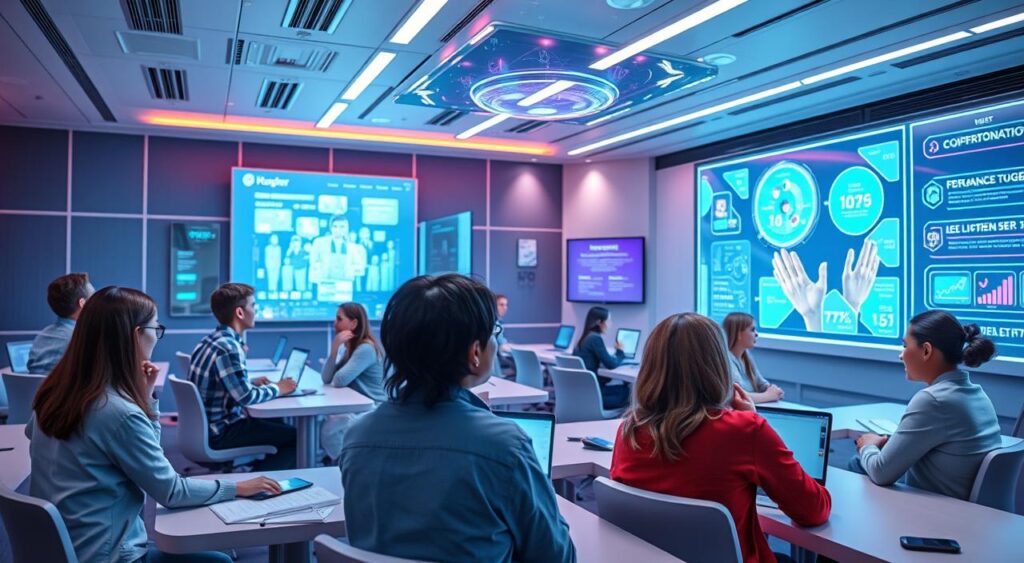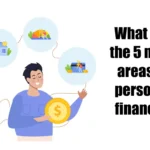Education is changing fast. The rise of competency-based online learning in 2025 is evident, with 75% of online courses adopting this approach. This marks a significant shift from current methods.
This change means we’re thinking differently about getting ready for work. It’s all about preparing for the 21st-century job market.
I’m excited to talk about competency-based online learning. It’s all about making learning personal and giving out micro-credentials. This new way of learning is changing how we get and show off our skills.
Let’s look into the future of learning. We’ll see how technology helps learners succeed in today’s world.

Understanding Competency-Based Education in the Digital Age
In today’s fast-changing world, competency-based education (CBE) is changing how we learn. It focuses on mastering skills and knowledge, not just sitting in class. This new way of learning puts the student in charge of their own success.
Key Components of Modern CBE Systems
Modern CBE systems are flexible and tailored to each student. They use adaptive assessments to check how well students know things. This helps teachers give each student the right help at the right time.
Learning analytics give teachers important information. They help teachers make smart choices to help students learn better.
Evolution from Traditional Learning Models
Competency-based education is different from old ways of learning. It doesn’t move students based on how long they sit in class. Instead, it lets students show they know things before moving on.
This lets students learn at their own speed. It makes learning feel more personal and exciting.
Benefits of Competency-Based Approaches
- Personalized learning experiences that cater to individual needs and learning styles
- Accelerated progress for students who demonstrate proficiency, allowing them to advance more quickly
- Increased engagement and motivation as learners take ownership of their own learning
- Improved alignment between education and the evolving demands of the workforce
As we move into the digital age, CBE is leading the way. It empowers learners and changes education for the better.

The Rise of Competency-Based Online Learning in 2025
Looking ahead to 2025, education is changing. Competency-based online learning is leading the way. It lets students learn at their own speed and show they know their stuff.
Immersive virtual classrooms are at the heart of this change. They offer real-world learning in a safe space. Students can try out their skills in a way that feels real.
AI-powered tutoring is also key. It helps students get the right help at the right time. This makes learning more personal and effective.
Adding to this, immersive simulations make learning even better. They let students practice in real-life situations. This helps them show off their skills in a fun and engaging way.
“The future of education lies in empowering students to learn at their own pace and showcase their abilities through practical, real-world applications. Competency-based online learning is the key to unlocking this potential.”
By 2025, we’ll see a big change in how we learn. Virtual classrooms, AI tutoring, and simulations will mix together. This will make learning more personal and focused on skills. It will get students ready for the 21st century.

Transforming Education Through Personalized Learning Pathways
Personalized learning pathways are changing how we learn. They use technology to make learning fit each person’s needs and goals.
Customized Learning Experiences
Education is no longer the same for everyone. Now, students can shape their own learning path. Teachers use technology to make plans that fit each student’s learning style and pace.
Adaptive Progress Tracking
Learning paths also focus on how fast students learn. Systems track how well students do and adjust the learning to keep it right for them.
Individual Skill Development Plans
These plans help students grow in areas they need to. They show a clear path for students to get the skills they need for school and work.
By using personalized learning, we’re making education better. It helps every student reach their highest potential.
AI-Powered Tutoring and Adaptive Assessments
Education is changing fast with the help of artificial intelligence (AI). AI tutoring systems are making learning better for students. They use smart algorithms to understand how each student learns and what they need to know.
Adaptive assessments are also changing how we check if students are learning. These tests change their questions based on what the student answers. This helps teachers see what each student knows and what they need to work on.
| Feature | Benefit |
|---|---|
| AI-powered tutoring | Personalized guidance and support for students, leading to improved learning outcomes. |
| Adaptive assessments | Accurate evaluation of student knowledge and skills, enabling tailored instruction. |
| Learning analytics | Data-driven insights to inform instructional strategies and track student progress. |
As we look to the future, AI tutoring and adaptive assessments will be key. They will make learning better for everyone. Students and teachers will be able to reach their highest goals.
“The future of education lies in the convergence of AI and personalized learning, where each student’s unique needs are addressed with precision and care.”
Micro-Credentials and Digital Badges: The New Currency of Education
Education is changing fast. Micro-credentials and digital badges are now key. They help show off skills and achievements. This makes it easier to stand out in the job market.
Industry Recognition and Validation
More employers are noticing micro-credentials and digital badges. They show off specific skills. This helps learners show they are ready for new jobs.
Stackable Credentials Framework
Micro-credentials and digital badges can be added to each other. This makes learning paths flexible. It lets learners focus on what they need for their career.
Portfolio Development Strategies
- Leverage micro-credentials and digital badges to build a robust and visually engaging digital portfolio.
- Showcase a diverse range of skills and accomplishments, from technical expertise to soft skills and personal achievements.
- Strategically select and combine relevant credentials to demonstrate a well-rounded, competent, and versatile professional profile.
Micro-credentials and digital badges are changing education. They open doors to new chances in the job world. By using them, learners can show off their skills and find success.
Data-Driven Instruction and Learning Analytics
In education, data-driven instruction and learning analytics are changing the game. They use data from students and teachers to find new ways to learn. This helps make learning paths that fit each student.
Learning analytics tools collect and study lots of data. They look at how well students do and how they like to learn. Teachers use this info to make lessons that fit each student’s needs.
“The future of education lies in our ability to leverage data to create truly personalized learning experiences that empower students to reach their full potential.”
With data-driven instruction, teachers can make better choices. They can see where students need help and use resources wisely. This makes learning more fun and effective for everyone.
The future of education is bright with learning analytics and data-driven instruction. These tools will help make learning more personal and effective. Teachers can help every student succeed with these tools.
Virtual Classrooms and Immersive Learning Environments
The world is changing fast, and so is education. Virtual classrooms and immersive learning are big news. They change how we learn and get new skills, like in online learning.
Advanced Simulation Technologies
Virtual classrooms now have cool tech. Students get to learn in a fun, hands-on way. They use 3D models and augmented reality to get better at complex stuff.
Collaborative Virtual Spaces
Learning online is no longer lonely. Virtual classrooms let students work together. They can share ideas and learn from each other in real time.
Real-time Interaction Tools
Good communication is key in learning. Virtual classrooms have tools like video chats and live chats. These help students and teachers talk and work together smoothly.
Virtual classrooms are the future of learning. They use cool tech and let students work together. This makes learning fun and interactive.
Workforce Upskilling Through Competency-Based Programs
Employers are now using online learning to improve their workers’ skills. These programs help employees learn the exact skills they need for their jobs. It’s a new way to learn that really works.
Micro-credentials are key in these programs. They are small digital badges that show you know something specific. This way, people can learn at their own speed. They get to follow personalized learning pathways and take adaptive assessments to show they’ve learned what they need to.
| Benefits for Employees | Benefits for Employers |
|---|---|
| Flexible, self-paced learning Relevant, job-specific skills Portable micro-credentials Increased confidence and career advancement | Targeted skills development Improved employee retention Streamlined recruitment and onboarding Increased organizational agility and competitiveness |
By using competency-based online learning, companies can help their workers stay up-to-date. They get the important skills they need to do well in today’s fast-changing job world.
“Competency-based education is a game-changer for employers looking to upskill their workforce and stay ahead of the curve. The ability to validate specific skills and knowledge through micro-credentials is invaluable in today’s rapidly evolving job market.”
The Role of Technology in Assessment and Validation
Technology is key in making sure assessments and validations are fair and reliable. It brings in new ways to check and confirm skills. These changes are amazing.
Blockchain Verification Systems
Blockchain technology has changed how we check if someone has the skills they say they do. It makes sure records are safe and can’t be changed. This helps build trust in skills and learning.
Performance Measurement Tools
New tools help us see how well someone can do things. They use data to give a clear picture of someone’s skills. This helps everyone make better choices based on real skills, not just grades.
Authentication Methods
New ways to make sure who you are are being used. Things like face scans and digital signatures help stop cheating. They make sure only the right person gets credit for their skills.
As education changes, technology will play an even bigger part. It will help make sure skills are recognized and valued the right way.
| Technology | Benefits | Key Features |
|---|---|---|
| Blockchain Verification Systems | Secure, tamper-proof credential validation | Decentralized, transparent record-keeping |
| Performance Measurement Tools | Comprehensive, data-driven assessment of competencies | Learning analytics, objective skill evaluation |
| Authentication Methods | Prevent fraud, ensure credential integrity | Biometric identification, digital signatures |
Challenges and Solutions in Implementation
The education world is always changing. This means new challenges when we try to use competency-based online learning. We need to know what these challenges are and how to solve them.
One big problem is making sure we have the right technology. We need fast internet, safe places to store data, and easy-to-use websites. These tools help make learning personal and based on data.
Teachers also face big challenges. They need to learn new ways of teaching. Giving them the right training and support is key to success.
- Addressing technological infrastructure requirements
- Implementing faculty training and development programs
- Aligning institutional policies and procedures with competency-based learning
- Fostering student engagement and acceptance of the new learning model
- Ensuring data privacy and security in a digital learning environment
We also need to change how schools work. This includes how we test students and give grades. Everyone in the school needs to work together to make this change smoothly.
By tackling these challenges head-on, schools can make a big change. This change will help students learn in new and exciting ways. It will make education more personal and effective.
Conclusion
The rise of online learning in 2025 is changing education. It uses personalized learning and AI to help people grow. This way, everyone can reach their best and get ready for the digital world.
This new learning method is very promising. It lets people learn in their own way and track their progress. It also helps them get special badges for their skills.
Technology will keep making online learning better. We will see more virtual classrooms and new ways to learn. This will help people learn in a way that fits them best. It will prepare them for the changing world of work.
FAQ
What is competency-based online learning, and how is it transforming education?
Competency-based online learning focuses on mastering skills and knowledge. It uses digital tools for personalized learning. This lets learners move at their own pace and show what they know.
How are personalized learning pathways shaping the future of education?
Personalized learning lets students tailor their education to fit their needs. It uses tracking and plans to help learners grow. This makes learning more effective and fun.
What role do micro-credentials and digital badges play in the new landscape of education?
Micro-credentials and digital badges show off specific skills. They help learners build a portfolio of their skills. This is important for getting jobs and showing what you can do.
How are AI-powered tutoring systems and adaptive assessments transforming the learning experience?
AI tutoring and adaptive assessments make learning more personal. They use technology to guide and track progress. This makes learning more effective and fun.
What are the benefits of competency-based online learning for the workforce and employers?
It helps workers get the skills they need for jobs. Employers can see what workers can do. This makes companies more competitive.
What are the key challenges in implementing competency-based online learning, and how can they be addressed?
Challenges include setting up technology and training teachers. It also means changing school rules to fit new learning ways. Working together can solve these problems.







